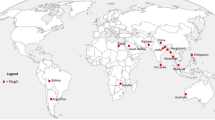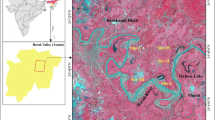Abstract
Arsenic (As) is a highly toxic metalloid. High As levels have been recorded in groundwater aquifers at a global scale. This study investigated As level in groundwater of District Vehari and assessed the potential of different agricultural by-products (sugarcane bagasse, cottonseed hulls, soybean hulls, corncobs and rice husk) to remove As from water. The study was carried out in two steps. In the first step, a total of 38 groundwater samples were obtained from Vehari. Groundwater samples were analyzed for total As contents and physicochemical parameters. Results indicated that As content ranged from below detection limit to 49 µg/L in the groundwater samples. The values of hazard quotient and cancer risk were up to 1.5 and 0.0004, respectively, which delineated severe risk of As poisoning. During the second step, six As-contaminated groundwater samples (total As contents: 49, 40, 29, 24, 18, 16 µg/L) were selected to remove As using agricultural by-products. Furthermore, four As solutions (200, 100, 50 and 25 µg/L) were prepared in the laboratory. Results revealed that corncobs and soybean hulls removed, respectively, 98% and 71% As from aqueous mediums after 120 min. Moreover, agricultural by-products were less effective in removing As from groundwater samples than synthetic solutions. The adsorption/removal capacity of by-products was lower at low initial As concentration compared to high initial levels, which needs further studies to explore the underlying mechanisms. Overall, the As removal efficiency of agriculture by-products differed significantly with respect to initial As level, contamination category, type of agricultural by-products and interaction duration. Therefore, these aspects need to be optimized before the possible use of an agricultural by-product as a potential biosorbent.

Similar content being viewed by others
References
Ali, S., Rizwan, M., Shakoor, M. B., Jilani, A., & Anjum, R. (2020). High sorption efficiency for As(III) and As(V) from aqueous solutions using novel almond shell biochar. Chemosphere, 243, 125330.
Alka, S., Shahir, S., Ibrahim, N., Ndejiko, M. J., Vo, D.-V.N., & Manan, F. A. (2021). Arsenic removal technologies and future trends: A mini review. Journal of Cleaner Production, 278, 123805.
Alvarez-Cruz, J. L., & Garrido-Hoyos, S. E. (2019). Effect of the mole ratio of Mn/Fe composites on arsenic (V) adsorption. Science of the total environment, 668, 47–55.
Amen, R., Bashir, H., Bibi, I., Shaheen, S. M., Niazi, N. K., Shahid, M., et al. (2020). A critical review on arsenic removal from water using biochar-based sorbents: The significance of modification and redox reactions. Chemical Engineering Journal, 396, 125195.
Delgado Quezada, V., Altamirano Espinoza, M., & Bundschuh, J. (2020). Arsenic in geoenvironments of Nicaragua: Exposure, health effects, mitigation and future needs. Science of the Total Environment, 716, 136527.
Natasha, Shahid, M., Khalid, S., Murtaza, B., Anwar, H., Shah, A. H., et al. (2020). A critical analysis of wastewater use in agriculture and associated health risks in Pakistan. Environmental Geochemistry and Health, 15(5), 895.
Niazi, N. K., Bibi, I., Shahid, M., Ok, Y. S., Burton, E. D., Wang, H., et al. (2018). Arsenic removal by perilla leaf biochar in aqueous solutions and groundwater: An integrated spectroscopic and microscopic examination. Environmental Pollution, 232, 31–41.
Podgorski, J., & Berg, M. (2020). Global threat of arsenic in groundwater. Science, 368(6493), 845–850.
Podgorski, J. E., Eqani, S. A. M. A. S., Khanam, T., Ullah, R., Shen, H., & Berg, M. (2017). Extensive arsenic contamination in high-pH unconfined aquifers in the Indus Valley. Science advances, 3(8), e1700935.
Rahman, M. M., Naidu, R., & Bhattacharya, P. (2009). Arsenic contamination in groundwater in the Southeast Asia region. Environmental geochemistry and health, 31(1), 9–21.
Rahman, M. A., Rahman, A., Khan, M. Z. K., & Renzaho, A. M. N. (2018). Human health risks and socio-economic perspectives of arsenic exposure in Bangladesh: A scoping review. Ecotoxicology and environmental safety, 150, 335–343.
Ryan, J., Estefan, G., & Rashid, A. (2007). Soil and plant analysis laboratory manual: ICARDA. In International center for agricultural research in the dry areas, pp. 172.
Shabbir, Z., Sardar, A., Shabbir, A., Abbas, G., Shamshad, S., Khalid, S., et al. (2020). Copper uptake, essentiality, toxicity, detoxification and risk assessment in soil-plant environment. Chemosphere, 259, 127436.
Shah, A. H., Shahid, M., Khalid, S., Shabbir, Z., Bakhat, H. F., Murtaza, B., et al. (2020). Assessment of arsenic exposure by drinking well water and associated carcinogenic risk in peri-urban areas of Vehari, Pakistan. Environmental Geochemistry and Health, 42, 121–133.
Shahid, M., Niazi, N. K., Dumat, C., Naidu, R., Khalid, S., Rahman, M. M., et al. (2018). A meta-analysis of the distribution, sources and health risks of arsenic-contaminated groundwater in Pakistan. Environmental pollution, 242, 307–319.
Shahid, M., Nadeem, M., & Bakhat, H. F. (2020). Environmental toxicology and associated human health risks. Environmental Science and Pollution Research, 27, 39671–39675.
Shahid, M., Natasha, Dumat, C., Niazi, N., Xiong, T., Farooq, A., et al. (2020b). Ecotoxicology of heavy metal(loid) enriched particulate matter: Foliar accumulation by plants and health impacts. In: Reviews of Environmental Contamination and Toxicology. Springer, NY. https://doi.org/10.1007/398_2019_38.
Shakoor, M., Niazi, N., Bibi, I., Rahman, M., Naidu, R., Dong, Z., et al. (2015). Unraveling health risk and speciation of arsenic from groundwater in rural areas of Punjab, Pakistan. International journal of environmental research and public health, 12(10), 12371–12390.
Shakoor, M. B., Niazi, N. K., Bibi, I., Murtaza, G., Kunhikrishnan, A., Seshadri, B., et al. (2016). Remediation of arsenic-contaminated water using agricultural wastes as biosorbents. Critical Reviews in Environmental Science and Technology, 46(5), 467–499.
Shakoor, M. B., Niazi, N. K., Bibi, I., Shahid, M., Saqib, Z. A., Nawaz, M. F., et al. (2019). Exploring the arsenic removal potential of various biosorbents from water. Environment International, 123, 567–579.
Tabassum, R. A., Shahid, M., Niazi, N. K., Dumat, C., Zhang, Y., Imran, M., et al. (2019). Arsenic removal from aqueous solutions and groundwater using agricultural biowastes-derived biosorbents and biochar: a column-scale investigation. International journal of phytoremediation, 21(6), 509–518.
Zoroufchi Benis, K., Motalebi Damuchali, A., Soltan, J., & McPhedran, K. N. (2020). Treatment of aqueous arsenic – A review of biochar modification methods. Science of the Total Environment, 739, 139750.
Acknowledgements
The corresponding author thanks the financial support from HEC Pakistan for research project “7770/Federal/ NRPU/R&D/HEC/ 2017” and ORIC, CUI for funding a project # 16-25/CRGP/CIIT/VEH/17/1141.
Author information
Authors and Affiliations
Corresponding author
Additional information
Publisher's Note
Springer Nature remains neutral with regard to jurisdictional claims in published maps and institutional affiliations.
Electronic supplementary material
Below is the link to the electronic supplementary material.
Rights and permissions
About this article
Cite this article
Shabbir, Z., Shahid, M., Natasha et al. Use of agricultural bio-wastes to remove arsenic from contaminated water. Environ Geochem Health 45, 5703–5712 (2023). https://doi.org/10.1007/s10653-020-00782-1
Received:
Accepted:
Published:
Issue Date:
DOI: https://doi.org/10.1007/s10653-020-00782-1




